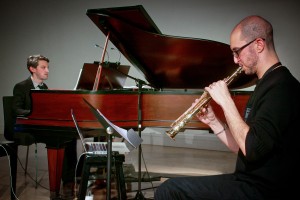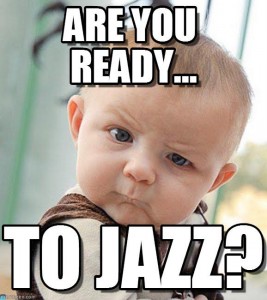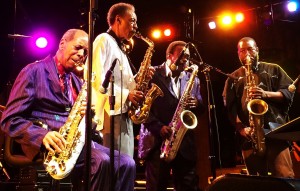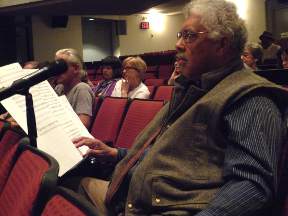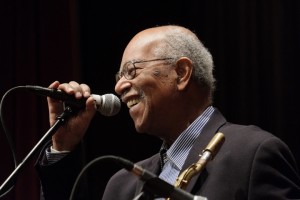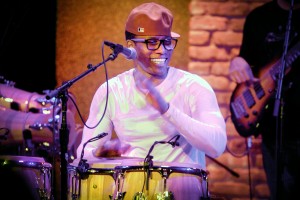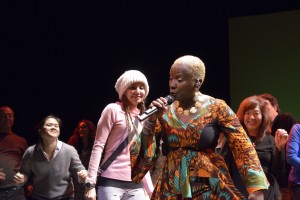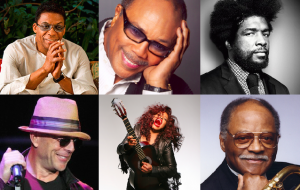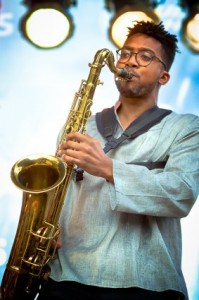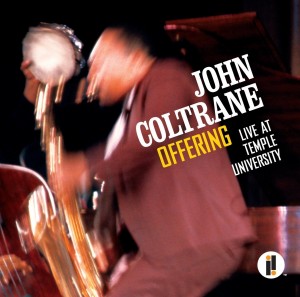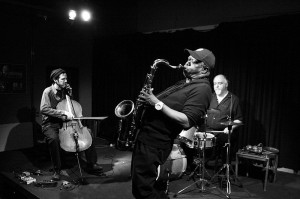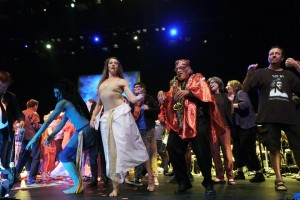When saxophonist Steve Lehman performs, I try to hear him whatever the setting. His octet, concertizing in Philadelphia for Ars Nova Workshop Saturday, March 21, plays richly microtonal yet melodically entrancing and rhythmically propulsive, synchronized music — partaking of a concept called “spectralism” — that brings to mind both Dolphy and Messiaen. In a sax-bass-drums trio, Lehman , […]
Jazz health is not in its reported records sales
Terry Teachout in his About Last Night posting “Jazz, by the numbers” conflates falling numbers of jazz cd sales with the health of the music itself. Understandable mixup, way too simple. Feeling he was burned by criticism of his 2009 Wall Street Journal column about the National Endowment for the Arts Survey of ÂPublic Participation — in […]
Ornette honored and playing in Prospect Park June 2014
In honor of Ornette Coleman’s 85th birthday (today, March 9), here’s my report from the last time he performed in New York City — at an extraordinary concert in his honor with Patti Smith, Laurie Anderson, Thurston Moore, Nels Cline, Sonny Rollins and many more at Prospect Park, Brooklyn. Originally published in The Wire. Ornette […]
New Yorkish New Orleans and Chicago Diva at Symphony Center
Butler, Bernstein and the Hot 9 — that’s pianist Henry Butler, brassy brassman and arranger Steven Bernstein, and their touring NYC-based all-stars — plus beloved local singer Dee Alexander with her trio were double billed on a cold, cold night last week (Feb. 27) at Chicago’s downtown Orchestra Hall in Symphony Center. It was the first time […]
Jazz composers meet symphony orchestra challenge
The American Composers Orchestra’s Jazz Composers Orchestra Initiative rides again — application deadline April for a two part intensive beginning August 2015. I blogged about at length about the Buffalo Philharmonic’s 2013 reading of  first symphonic works by five highly skilled performer-composers who otherwise would be hard-pressed get a chance to write for such an ensemble. Subsequently I interviewed […]
Hail to college jazz radio stations like WHPK
WHPK, Chicago’s Hyde Park-based non-profit jazz-broadcasting community radio station at 88.5 fm, held its annual Black History Month gala last Saturday (Feb 21) with music by reedsman Ari Brown‘s quartet celebrating the 50th anniversary year of the AACM (Association for the Advancement of Creative Musicians). International House, where the party was held, was an appropriate setting, as it’s […]
Pedrito Martinez’ Cuba-in-Cold-Midwest tour
Conguero Pedrito Martinez brought his charismatic Afro-Cuban quartet to Chicago’s City Winery last night (Feb. 15), pleasing an upbeat crowd at the supper set (and no doubt later show, too) with an up-to-date performance of roots rhythms, solo and group singing and tightly synchronized, syncopated play. Accompanied by fleet keyboardist Edgar Pantoja-Aleman, electric bassist Alvaro Benavides, and percussionist Jhair Sala […]
New Frequencies fest in SF: community jazz-beyond-jazz
Inexhaustible Angelique Kidjo singing her ya-yas out about serious issues amid an onstage throng — the Latin Jazz Youth Ensemble of San Francisco at noon on a Saturday reviving Cuban conga with free-styling dancers — women prominent among the fervently unfettered improvisers and daring composers leading ace ensembles.  The New Frequencies festival: Jazz@YBCA (Yerba Buena Center for the Arts) put […]
Jazz men and women — and jazz itself — honored
Tonight (Oct. 24) will be a Great Night in Harlem, as pianist Herbie Hancock, winner of the Jazz Journalists Association’s 2014 Award for Lifetime Achievement in Jazz, receives likewise recognition at the Jazz Foundation of America’s gala fundraising show (goal: $1.7 million to help health-, housing- and employment-challenged jazz and blues musicians), genuinely studded with stars and heartfelt […]
Another free Chicago jazz festival: Hyde Park and local stars
The 8th annual Hyde Park Jazz Festival Sept 27 and 28th was as mellowly festive a scene as has ever graced the Midway Plaisance, the grassy fields between University of Chicago’s faux Gothic buildings, originally created for the 1893 World’s Columbian Exposition. Photo-journalist Michael Jackson created portraits of local fans and players such as Irvin Pierce, last-minute tenor […]
Beautiful Coltrane birthday — celebrate with “Offering”
Today, Sept 23, is a beautiful 88th birthdate of the late revered and intrepid saxophonist/composer John Coltrane, celebrated with the release of Offering, the first professionally prepared cd of his November 1966 concert at Temple University. This is the most significant addition to Coltrane’s ouevre since the 2005 discovery by Library of Congress researcher Larry Appelbaum of the concert […]
The funeral at the Hideout, with Survival Unit III
After nine years, the free-thinking Immediate Sound  Series ended at Chicago’s indie-alt. Hideout on Sept. 17. Survival Unit III, the decade-old but only  occasionally united ensemble of multi-instrumentalist Joe McPhee (from Poughkeepsie) and Chicago-based cellist Fred Lonberg-Holm and drummer Michael Zerang performed highly sympatico improvisations before a rapt and appreciative audience of aficionados and sometimes-collaborators, […]
Guelph’s jazz fest/colloquium of cosmic improvisation, Deutsch pix
The Guelph Jazz Festival last week (Sept 3 through 7), held in a mostly placid river-run university town about 60 miles west of Toronto, climaxed with a blast-off to other worlds fueled by the Sun Ra Arkestra (led by saxophonist Marshall Allen) and Coleman Lemieux & Compagnie dance troupe. Photographer Lauren Deutsch captured the ecstasy […]

